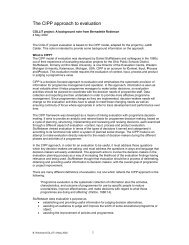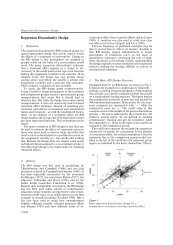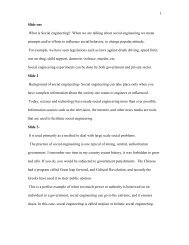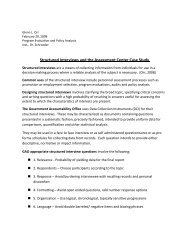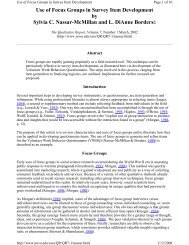The Problem
The Problem
The Problem
Create successful ePaper yourself
Turn your PDF publications into a flip-book with our unique Google optimized e-Paper software.
unhelpful. As Melissa Powell notes, more often than not, the problem is not whether to<br />
include stakeholders, but who gets included and who doesn’t (1997). In the case of the<br />
ATIS, the success of the entire project rested upon how the advisory board was set-up<br />
and on the outcome of the strategic planning session. Hence, substantial resources were<br />
invested simply to begin to understand the dynamics of the existing network, and<br />
planning out how and who should be involved. In retrospect, we believe that a<br />
stakeholder analysis methodology, such as the one devised above, has greatly enhanced<br />
our ability to maneuver more effectively within this network.<br />
One cannot underestimate the importance of optimizing one’s resources in situations<br />
where time, people and other resources are limited. Ideally, one would like to have<br />
processes where every interested party should be allowed effective participation. To be<br />
sure, every successful program must involve at some point all relevant voices. <strong>The</strong> utility<br />
of an approach such as the one offered here is that in many cases, different interests can<br />
only participate effectively at particular points in the process. Each step of a program<br />
will have different goals and different dynamics to consider.<br />
VIII. Conclusion<br />
<strong>The</strong> Complexity of Joint Action<br />
In their landmark study of implementation, Pressman and Wildavsky (1973) presented a<br />
case study of how a project with seemingly unanimous support, was considered a good<br />
and valuable project by all, failed miserably. We believe that the approach and<br />
methodology presented here provides managers a way of avoiding the pitfalls besieged<br />
by the actors in Pressman and Wildavsky’s book. As noted above, the most time<br />
consuming phase of a project will increasingly become the initial assessment stages. As<br />
public administrators increasingly become facilitators, as opposed to director’s, the need<br />
to “feel out” a problems various participants will be critical to effective implementation<br />
strategies. That is, through a better understanding of the network involved in any given<br />
policy area using some derivation of the stakeholder management approach offered<br />
23




